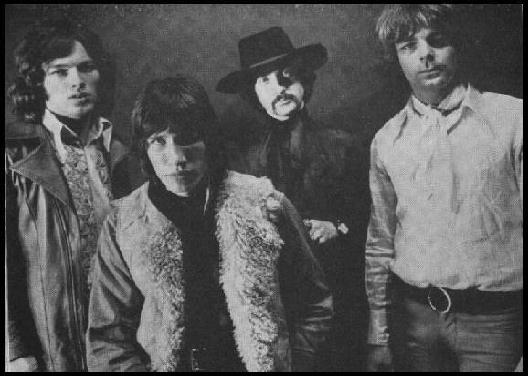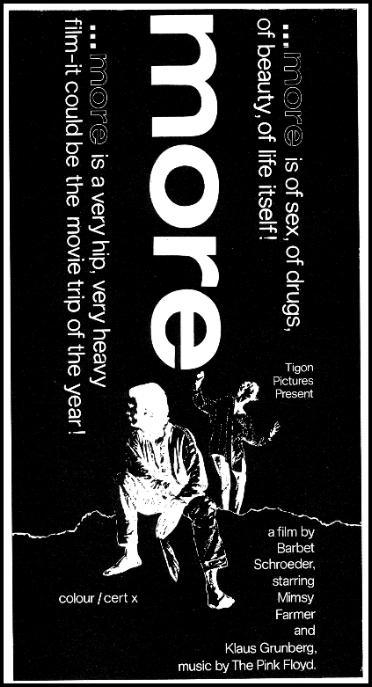

Thousand Miles Of Moonlight Later
(1968-1970)
by Mick Capewell

At the beginning of 1968, only the most supreme of optimists would have predicted a golden future for The Pink Floyd. After a year that had seen them achieve notoriety with their 'psychedelic' live shows and commercial success with their first two singles, the group had suffered a series of set-backs. Their third single 'Apples and Oranges' had flopped. Venturing out from their 'underground' London Club lair, their live appearances in provincial towns had provoked acrimony from audiences who, unused to lengthy improvised psychedelic 'jamming', had expected to hear the 'hits'. A trip to the USA to make several television appearances and to play selected live dates was a disastrous shambles, mainly due to the deteriorating mental state of singer/guitarist Syd Barrett. By the end of 1967 it was obvious that Syd was incapable of functioning within the band. Dave Gilmour, ex-Jokers Wild guitarist and an old friend of Syd's was drafted in to bolster the group and cover for Syd's unreliability. The five man Floyd lasted for five gigs. The others simply didn't bother to collect Syd before the sixth, and that was that. So there they were. Their sales were diving, the 'scene' was changing, and they had lost their leader; the singer, the innovative lead guitarist, the main song-writer, the focus of attention, the apparently irreplaceable 'public face' of the group. The group's managers abandoned the group as they had decided that Syd was the better bet for continued success, despite his obvious problems.
So how did The Pink Floyd survive, to become, by 1970, one of the biggest acts in the world?
The first vital component was Gilmour. It's very rare for a group to be able to adequately replace someone as important as Syd undoubtedly had been. Normally, fans either move with the departing member, or at best they give the new man their fleeting attention before deciding that things aren't the same, subsequently losing interest. In a business full of fragile egos impatient for success, the pressures are usually intolerable and crushing for the replacement. Dave Gilmour , however, appeared to be a strong, confident character, well able to cope with anything that was thrown in his direction. Lacking Syd's erratic, quicksilver brilliance, Gilmour knew that it would be futile to attempt to copy Syd's style. Instead he concentrated on moulding a guitar technique and sound that would effectively compliment the old Floyd sound but would also lay sturdy foundations allowing progression away from Lewis Carroll inspired psych/pop and chaotic free-form improvisations towards more classically arranged pieces; though remaining notionally within the realms of the avant-garde. Perhaps even more crucial than the assimilation of Gilmour was the grasping of the leadership nettle by Roger Waters, and his emergence as a song-writer of stature. In the long term of course, it transpired that Waters was an even deeper whirlpool of neuroses than Barrett; sub-concious anger sparking confrontational 70s epics such as 'Animals' and 'The Wall' , but in '68 The Pink Floyd needed a direction and Waters provided them with it, pointing at the sky while keeping one foot firmly planted in the verdant pastures of the countryside.
It Would Be So Nice. The fourth single, another utter flop and this time, unlike the wild, inventive 'Apples and Oranges', thoroughly deserving of it's fate. A Rick Wright composition and sung by him in a very formal, limp manner. The song is now remembered only for the mild controversy concerning the mention of the 'Evening Standard' in the lyric. After threats of legal action (or was it just a publicity stunt?), the offending line was changed to 'Daily Standard' . Nobody noticed!
Julia Dream. The B side was far more convincing. A gentle, acoustic slice of pastoral psychedelia, but with lyrics more nightmare than dream, a juxta-position of mood and feeling that became a Floydian trademark.
 A
Saucerful of Secrets. The crucial second album. The release that
would define the group's career, not only by setting an agenda
for their future, but in determining that the group had a future
at all. Judging the 'book' by it's cover, the signs looked good.
The Hipgnosis design was a masterpiece of colourful elusiveness,
re-inforcing the air of collective inscrutability that the Floyd
had adopted as group policy. The contents were inconsistent and
schizophrenic. The band's avant-garde/ science fiction direction
was well represented by the opener 'Let There Be More Light' ,
the marathon, multi-faceted title track and the minimalist
classic 'Set the Controls For the Heart of the Sun' . However,
the past refused to be shaken off so easily. 'Remember a Day' ,
composed by Wright featured brittle slide guitar courtesy of Syd.
'See-Saw' , another Wright song, had rejoiced in the working
title of 'The Most Boring Song I've Ever Heard Bar Two', which
was frankly a generous description! 'Corporal Clegg', with it's
kazoo chorus and silly lyrics seemed to be a too self-concious
attempt to emulate Syd's inspired lunacy. Barrett in fact,
provided the album's closer, 'Jugband Blues', a song which, owing
to Syd's circumstances probably rates among the most poignant
moments in British Rock music. The immortal opening lines-It's
awfully nice of you to think of me here/ And I'm most obliged to
you for making it clear/ That I'm really not here- are almost
unbearably chilling in their naivete. The stop-start, haphazard
structure of the song seemed to perfectly echo Syd's fractured
state of mind. The final moments feature a ghostly Syd, seemingly
intoning his words from atop a cloud:
A
Saucerful of Secrets. The crucial second album. The release that
would define the group's career, not only by setting an agenda
for their future, but in determining that the group had a future
at all. Judging the 'book' by it's cover, the signs looked good.
The Hipgnosis design was a masterpiece of colourful elusiveness,
re-inforcing the air of collective inscrutability that the Floyd
had adopted as group policy. The contents were inconsistent and
schizophrenic. The band's avant-garde/ science fiction direction
was well represented by the opener 'Let There Be More Light' ,
the marathon, multi-faceted title track and the minimalist
classic 'Set the Controls For the Heart of the Sun' . However,
the past refused to be shaken off so easily. 'Remember a Day' ,
composed by Wright featured brittle slide guitar courtesy of Syd.
'See-Saw' , another Wright song, had rejoiced in the working
title of 'The Most Boring Song I've Ever Heard Bar Two', which
was frankly a generous description! 'Corporal Clegg', with it's
kazoo chorus and silly lyrics seemed to be a too self-concious
attempt to emulate Syd's inspired lunacy. Barrett in fact,
provided the album's closer, 'Jugband Blues', a song which, owing
to Syd's circumstances probably rates among the most poignant
moments in British Rock music. The immortal opening lines-It's
awfully nice of you to think of me here/ And I'm most obliged to
you for making it clear/ That I'm really not here- are almost
unbearably chilling in their naivete. The stop-start, haphazard
structure of the song seemed to perfectly echo Syd's fractured
state of mind. The final moments feature a ghostly Syd, seemingly
intoning his words from atop a cloud:
'And the sea isn't green,
And I love the Queen,
And what exactly is a dream,
And what exactly is a joke'.
No laughing matter, but a seriously apt way to bring the curtain down on the Barrett-era. Despite the patchy quality of the overall album, 'Set the Controls For the Heart of the Sun' in particular proved that the Floyd were certainly capable of attaining top-line status. Influenced by, and an influence on the emerging German bands such as Can, the track was built around a mechanical, yet rolling drum pattern. Bass guitar overlayed the rhythm and Wright provided understated keyboard fills and effects. Waters' almost whispered vocals were buried deep within the cavernous mix, adding to the feeling of space, distance and timelessness.
The album scraped into the UK album Top Ten chart. Not as impressive sales wise as 'Piper at the Gates of Dawn', but successful enough to renew confidence and allay any record company doubts.
Point Me At the Sky. A final (late '68) half-hearted tilt at the singles chart. The lyrical theme is of escaping from an over-crowded world by blasting off into the freedom of space but it's expressed in a rather foolish manner. The music lurches from quiet verses to kitchen-sink melodrama choruses with Gilmour seriously abusing his wah-wah pedal. After this release failed to set the charts on fire the group decided to concentrate exclusively on albums, cultivating a more aloof, reclusive image in the process.
Careful With That Axe,
Eugene. This was more like it! A classically Floydian on-off bass
riff underpinned a lengthy track that was more representative of
their new, stolid approach. Several minutes of relaxed keyboard
and wordless vocal exploration elapse as the atmosphere gradually
becomes more tense. Suddenly a terrifying Waters scream breaks
the chains, unleashing Gilmour and Mason to pummel the listener's
ear-drums into submission. Eventually the volume is reined in and
the circle is completed. The seismic tremors reduce and there is
a return to stillness. Simple yet stunningly effective. 
 More.
Spacey, atmospheric music was ideal for film soundtracks, and
following Ligeti's influential choral pieces used by Stanley
Kubrick in 2001: A Space Odyssey, it was only natural that the
Floyd would find themselves in demand. 'More', released in '69
was therefore surprising in that it features structured songs
rather than aimless improvisations. Several tracks became
particularly popular. 'Cymbeline' was a soft ballad with a
memorable chorus line. 'Green Is the Colour' became a live
feature for several years. 'The Nile Song' saw the group
indulging in stomping, overly frantic Heavy-Rock. 'Cirrus Minor'
was pastoral 'Space-Rock' par excellance. A lovely acoustic
ballad full of idyllic images : churchyards, rivers, lazing in
the sunshine etc, which give way to a protracted, luminous coda
that features Wright's organ work at it's statically
shape-shifting zenith.
More.
Spacey, atmospheric music was ideal for film soundtracks, and
following Ligeti's influential choral pieces used by Stanley
Kubrick in 2001: A Space Odyssey, it was only natural that the
Floyd would find themselves in demand. 'More', released in '69
was therefore surprising in that it features structured songs
rather than aimless improvisations. Several tracks became
particularly popular. 'Cymbeline' was a soft ballad with a
memorable chorus line. 'Green Is the Colour' became a live
feature for several years. 'The Nile Song' saw the group
indulging in stomping, overly frantic Heavy-Rock. 'Cirrus Minor'
was pastoral 'Space-Rock' par excellance. A lovely acoustic
ballad full of idyllic images : churchyards, rivers, lazing in
the sunshine etc, which give way to a protracted, luminous coda
that features Wright's organ work at it's statically
shape-shifting zenith.
Zabriskie Point. This was the much anticipated American debut of director Michelangelo Antonioni. The Floyd were to provide the soundtrack, leading to two weeks of recording sessions in Rome. The group approached the project with a lack of motivation and later dismissed the sessions as being akin to a lazy holiday in the sun. Indeed when the soundtrack album eventually appeared it contained only three Pink Floyd tracks, alongside the likes of The Grateful Dead and The Youngbloods. 'Heartbeat Pigmeat' was a percussive second cousin to 'Set the Controls'. 'Crumbling Land' was inoffensive country rock. 'Come In No 51 Your Time Is Up' was actually a stunningly violent version of 'Careful With That Axe, Eugene' and was used to great effect in the film to accompany the climactic scene of a large building exploding in the desert. The group's sojourn in Rome actually wasn't as unproductive as they claimed. Prototypes of several tracks that appeared on later albums had their Genesis in these sessions. For instance, 'The Narrow Way' from 'Ummagumma' derived from a piece entitled 'Rain in the Country' , while 'Dark Side of the Moon's' 'Us and Them' was originally an instrumental piece called 'The Violent Sequence'.
Over twenty five years later an expanded double CD of music recorded for 'Zabriskie Point' appeared. Aside from some gorgeous Jerry Garcia tracks, several 'new' instrumental Floyd pieces were included. In fact, the soundtrack was better regarded than the film, universally panned on release, ever was.
 Ummagumma. The Pink Floyd were
renowned for their live shows even more than for their studio
experiments. As lighting and sound equipment became more
sophisticated the Floyd were in the vanguard. They developed a
360 degree sound system, dubbed the 'Azimuth Co-ordinator' which
was claimed to provide the best possible sound at all parts of a
venue. Evidence of their post-Syd live prowess appeared on the
first disc of this double album. Recorded in the spring of 1969,
mainly at the legendary Mothers Club in Birmingham, storming
versions of 'Careful With That Axe, Eugene' , 'A Saucerful of
secrets' , 'Set the Controls For the Heart of the Sun' and
'Astronomy Domine' (the one nod back to the Syd era) were
included. Light shows were not included!
Ummagumma. The Pink Floyd were
renowned for their live shows even more than for their studio
experiments. As lighting and sound equipment became more
sophisticated the Floyd were in the vanguard. They developed a
360 degree sound system, dubbed the 'Azimuth Co-ordinator' which
was claimed to provide the best possible sound at all parts of a
venue. Evidence of their post-Syd live prowess appeared on the
first disc of this double album. Recorded in the spring of 1969,
mainly at the legendary Mothers Club in Birmingham, storming
versions of 'Careful With That Axe, Eugene' , 'A Saucerful of
secrets' , 'Set the Controls For the Heart of the Sun' and
'Astronomy Domine' (the one nod back to the Syd era) were
included. Light shows were not included!
The second disc was an oddity in that each group member had been allotted half a side to indulge their solo ideas. The results were mainly self-indulgent but the odd shard of inspiration can be found within the dross. Wright's 'Sysyphus' was a multi-part avant-garde instrumental, hardly riveting but containing a few interesting sequences, many of which were subsequently used as jingles by DJ Alan 'Fluff' Freeman. Nick Mason's three part percussion extravaganza 'The Grand Vizier's Garden Party' was as excessive and tedious as it's title suggests.
Roger Waters' contributions ranged from the sublime-'Grantchester Meadows' , another outdoor acoustic ballad-to the ridiculous 'Several Species of Small Furry Animals Gathered Together in a Cave and Grooving With a Pict'. Dave Gilmour's afore-mentioned 'The Narrow Way' easily took the honours. A whirling, bright-steel opening-a heavy, droning, percussive middle section-and a yearning, shimmering conclusion added up to a superb slice of progressive music.
The album went Top 5 in the UK charts and also became the group's first American chart entry. Housed inside another famous Hipgnosis cover 'Ummagumma' remains a favourite with fans to this day. As the new decade beckoned it seemed that the Floyd's career was firmly back on an upward trajectory, but after an elongated period of film soundtracks, live material and solo showboating, they now had to knuckle down and create their first purpose-built studio album since 'A Saucerful of Secrets', an album that would set them on course for the big league in the 70s.
 Atom
Heart Mother. Cows! A side-long instrumental title track that
concerned itself with the life, habits and bodily functions of
our cud-chewing friends dominated the album. This new piece,
co-created with Waters' friend and occasional collaborator Ron
Geesin, extended the prototype of the 'Saucerful' title track,
initially stating a dominant theme (augmented by an orchestra)
and then running through a variety of moods and styles-blues
guitar, wailing choir, electronic belches-each linking back to
the recurring theme and culminating in a strident finale.
Unfortunately there just weren't enough good ideas to save the
piece from falling into the category of 'dull' . Once again
Gilmour shines with his solo guitar during the 'Funky Dung'
segment but overall this was an artistic disappointment. The fire
and spontaneity of three years earlier was long gone, and despite
grandiose pretensions such as this, the Floyd still gave the
impression that they were floundering, still searching for that
elusive spark.
Atom
Heart Mother. Cows! A side-long instrumental title track that
concerned itself with the life, habits and bodily functions of
our cud-chewing friends dominated the album. This new piece,
co-created with Waters' friend and occasional collaborator Ron
Geesin, extended the prototype of the 'Saucerful' title track,
initially stating a dominant theme (augmented by an orchestra)
and then running through a variety of moods and styles-blues
guitar, wailing choir, electronic belches-each linking back to
the recurring theme and culminating in a strident finale.
Unfortunately there just weren't enough good ideas to save the
piece from falling into the category of 'dull' . Once again
Gilmour shines with his solo guitar during the 'Funky Dung'
segment but overall this was an artistic disappointment. The fire
and spontaneity of three years earlier was long gone, and despite
grandiose pretensions such as this, the Floyd still gave the
impression that they were floundering, still searching for that
elusive spark.
The second side of the album is generally forgotten, overshadowed by the title track. To be frank, 'Alan's Psychedelic Breakfast' deserves to be quickly forgotten. It's an indulgent mess that try's to be too clever by half, unless of course you enjoy listening to a stoned 'Hippy' (Mason) frying bacon and eggs! The Floyd were pioneers in the use of the recording studio as an 'instrument' but in this case they forget to use their ideas as a platform to entertain.
The remaining three tracks continued the 'Ummagumma' solo formula on a smaller scale, with Wright, Waters and Gilmour each contributing one song. Wright's 'Summer 69' was another nondescript effort, albeit this time with a recognizable chorus hook. Waters' 'If' marked the beginning on record of his fascination with the fragility of one's sanity. Gentle, acoustic music and a sweet, innocent vocal delivery contrast with the lyrics-'If I go insane, please don't put your wires in my brain' . This was the path to follow decided Waters, so follow it they did, in a big way!
Yet again it was left to Gilmour to provide the highlight with the uplifting 'Fat Old Sun' .The track employs church bells, mellifluous guitar, gentle organ and delicate vocals to paint a very English picture before Gilmour rips into one of his characteristic soaring guitar solos, ending the album on a triumphant note and partly atoning for the listlessness of the preceding performances.
'Atom Heart Mother' may not have been a total artistic success but it quickly proved itself to be a commercial phenomenon. A live presentation of the title piece at the Bath Festival assisted in the ascent to the No 1 position in the British charts and a Top 50 placing in the USA. From this point onward, every Pink Floyd release and tour was a guaranteed spectacular success. They had now left Psychedelia far behind, adapting their style to embrace the fashionable 'Progressive Rock' , while utilising an ingenious array of sound and visual effects and props. Cutting edge technology and huge presentations became the order of the day, but still Syd Barrett's ghost had not been completely laid to rest. Perhaps it never would be, and as Roger Waters often invoked Syd's memory in his lyrics, it seemed that The Pink Floyd had decided to not even try.